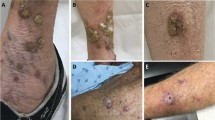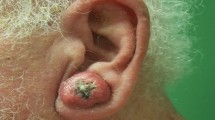Abstract
Fresolimumab is an antibody capable of neutralizing all human isoforms of transforming growth factor beta (TGFβ) and has demonstrated anticancer activity in investigational studies. Inhibition of TGFβ by fresolimumab can potentially result in the development of cutaneous lesions. The aim of this study was to investigate the clinical, histological, and immunohistochemical characteristics of cutaneous neoplasms associated with fresolimumab. Skin biopsies (n = 24) were collected and analyzed from patients (n = 5) with treatment-emergent, cutaneous lesions arising during a phase 1 study of multiple doses of fresolimumab in patients (n = 29) with melanoma or renal cell carcinoma. Blinded, independent histological review and measurements of Ki-67, p53, and HPV integration were performed. Based on central review, four patients developed lesions with histological characteristics of keratoacanthomas, and of these patients, a single case of well-differentiated squamous cell carcinoma was also found. Expression of Ki-67, no evidence of p53 overexpression, and only focal positivity for human papillomavirus RNA by in situ hybridization in 4/18 cases were consistent with these findings. Following completion of fresolimumab, lesions spontaneously resolved. Therefore, benign, reversible keratoacanthomas were the most common cutaneous neoplasms observed, a finding of importance for adverse event monitoring, patient care, and optimization of therapies targeting TGFβ.


Similar content being viewed by others
Abbreviations
- AE/SAE:
-
Adverse events/serious adverse events
- Akt:
-
Protein kinase B
- ALK:
-
Anaplastic lymphoma receptor tyrosine kinase
- ERK:
-
Extracellular signal-regulated kinase
- HPV:
-
Human papillomavirus
- IHC:
-
Immunohistochemical
- IgG:
-
Immunoglobulin
- JNK:
-
Jun N-terminal kinase
- KA:
-
Keratoacanthoma
- Kg:
-
Kilograms
- Ki:
-
Kinesis
- KO:
-
Knockout
- Mg:
-
Milligrams
- MM:
-
Malignant melanoma
- NCI:
-
National Cancer Institute
- RAF:
-
Rapidly accelerated fibrosarcoma
- RAS:
-
Rat sarcoma
- RCC:
-
Renal cell carcinoma
- SCC:
-
Squamous cell carcinoma
- SMAD:
-
Small body size mothers against decapentaplegic
- TGFβ:
-
Transforming growth factor β
- TGFBR:
-
Transforming growth factor β receptor
References
Roberts AB, Anzano MA, Lamb LC, Smith JM, Sporn MB (1981) New class of transforming growth factors potentiated by epidermal growth factor: isolation from non-neoplastic tissues. Proc Natl Acad Sci USA 78(9):5339–5343
Massague J (2008) TGFbeta in cancer. Cell 134(2):215–230
Tan AR, Alexe G, Reiss M (2009) Transforming growth factor-beta signaling: Emerging stem cell target in metastatic breast cancer? Breast Cancer Res Treat 115(3):453–495
Wrzesinski SH, Wan YY, Flavell RA (2007) Transforming growth factor-beta and the immune response: implications for anticancer therapy. Clin Cancer Res 13(18 Pt 1):5262–5270
Morris JC, Shapiro GI, Tan AR, Lawrence DP, Olenki TE, Dezube BJ, Hsu FJ, Reiss M, Berzofsky JA (2008) Phase I/II Study of GC1008: a human anti-transforming growth factor-beta (TGFβ) monoclonal antibody (MAb) in patients with advanced malignant melanoma (MM) or renal cell carcinoma (RCC). J Clin Oncol. ASCO Annual Meeting Proceedings (Post-Meeting Edition). Vol 26, no 15S (May 20 Supplement): 9028
Morris JC, Tan AR, Olencki TE, Shapiro GI, Dezube BJ, Reiss M, Hsu FJ, Berzofsky JA, Lawrence DP (2014) Phase I study of GC1008 (fresolimumab): a human anti-transforming growth factor-beta (TGFbeta) monoclonal antibody in patients with advanced malignant melanoma or renal cell carcinoma. PLoS One 9(3):e90353
Shirakata Y (2010) Regulation of epidermal keratinocytes by growth factors. J Dermatol Sci 59(2):73–80
Zhang YE (2009) Non-smad pathways in TGF-beta signaling. Cell Res 19(1):128–139
Arnault JP, Wechsler J, Escudier B, Spatz A, Tomasic G, Sibaud V, Aractingi S, Grange JD, Poirier-Colame V, Malka D, Soria JC, Mateus C, Robert C (2009) Keratoacanthomas and squamous cell carcinomas in patients receiving sorafenib. J Clin Oncol 27(23):e59–e61
Arnault JP, Mateus C, Escudier B, Tomasic G, Wechsler J, Hollville E, Soria JC, Malka D, Sarasin A, Larcher M, Andre J, Kamsu-Kom N, Boussemart L, Lacroix L, Spatz A, Eggermont AM, Druillennec S, Vagner S, Eychene A, Dumaz N, Robert C (2012) Skin tumors induced by sorafenib; paradoxic RAS–RAF pathway activation and oncogenic mutations of HRAS, TP53, and TGFBR1. Clin Cancer Res 18(1):263–272
Esser AC, Abril A, Fayne S, Doyle JA (2004) Acute development of multiple keratoacanthomas and squamous cell carcinomas after treatment with infliximab. J Am Acad Dermatol 50(5 Suppl):S75–S77
Chapman PB, Hauschild A, Robert C, Haanen JB, Ascierto P, Larkin J, Dummer R, Garbe C, Testori A, Maio M, Hogg D, Lorigan P, Lebbe C, Jouary T, Schadendorf D, Ribas A, O’Day SJ, Sosman JA, Kirkwood JM, Eggermont AM, Dreno B, Nolop K, Li J, Nelson B, Hou J, Lee RJ, Flaherty KT, McArthur GA (2011) Improved survival with vemurafenib in melanoma with BRAF V600E mutation. N Engl J Med 364(26):2507–2516
Su F, Viros A, Milagre C, Trunzer K, Bollag G, Spleiss O, Reis-Filho JS, Kong X, Koya RC, Flaherty KT, Chapman PB, Kim MJ, Hayward R, Martin M, Yang H, Wang Q, Hilton H, Hang JS, Noe J, Lambros M, Geyer F, Dhomen N, Niculescu-Duvaz I, Zambon A, Niculescu-Duvaz D, Preece N, Robert L, Otte NJ, Mok S, Kee D, Ma Y, Zhang C, Habets G, Burton EA, Wong B, Nguyen H, Kockx M, Andries L, Lestini B, Nolop KB, Lee RJ, Joe AK, Troy JL, Gonzalez R, Hutson TE, Puzanov I, Chmielowski B, Springer CJ, McArthur GA, Sosman JA, Lo RS, Ribas A, Marais R (2012) RAS mutations in cutaneous squamous-cell carcinomas in patients treated with BRAF inhibitors. N Engl J Med 366(3):207–215
Kefford R, Arkenau H, Brown MP, Millward M, Infante JR, Long GV, Ouellet D, Curtis M, Lebowitz PF, Falchook GS (2010) Phase I/II study of GSK2118436, a selective inhibitor of oncogenic mutant BRAF kinase, in patients with metastatic melanoma and other solid tumors. ASCO Annual Meeting, J Clin Oncol, 28:15s, (suppl; abstr 8503)
Anforth RM, Blumetti TC, Kefford RF, Sharma R, Scolyer RA, Kossard S, Long GV, Fernandez-Penas P (2012) Cutaneous manifestations of dabrafenib (GSK2118436): a selective inhibitor of mutant BRAF in patients with metastatic melanoma. Br J Dermatol 167(5):1153–1160
Suk JD, Park WS, Kim DK (2009) Low rates of somatic p53 mutations in keratoacanthomas. J Dermatol Sci 53(1):72–73
Batinac T, Zamolo G, Coklo M, Hadzisejdic I, Stemberger C, Zauhar G (2006) Expression of cell cycle and apoptosis regulatory proteins in keratoacanthoma and squamous cell carcinoma. Pathol Res Pract 202(8):599–607
Sakiz D, Turkmenoglu TT, Kabukcuoglu F (2009) The expression of p63 and p53 in keratoacanthoma and intraepidermal and invasive neoplasms of the skin. Pathol Res Pract 205(9):589–594
Kanner WA, Brill LB 2nd, Patterson JW, Wick MR (2010) CD10, p63 and CD99 expression in the differential diagnosis of atypical fibroxanthoma, spindle cell squamous cell carcinoma and desmoplastic melanoma. J Cutan Pathol 37(7):744–750
Karaa A, Khachemoune A (2007) Keratoacanthoma: a tumor in search of a classification. Int J Dermatol 46(7):671–678
Putti TC, Teh M, Lee YS (2004) Biological behavior of keratoacanthoma and squamous cell carcinoma: telomerase activity and COX-2 as potential markers. Mod Pathol 17(4):468–475
Ko CJ (2010) Keratoacanthoma: facts and controversies. Clin Dermatol 28(3):254–261
Schwartz RA (1994) Keratoacanthoma. J Am Acad Dermatol 30(1):1–19
Kossard S, Tan KB, Choy C (2008) Keratoacanthoma and infundibulocystic squamous cell carcinoma. Am J Dermatopathol 30(2):127–134
Kulkarni AB, Huh CG, Becker D, Geiser A, Lyght M, Flanders KC, Roberts AB, Sporn MB, Ward JM, Karlsson S (1993) Transforming growth factor beta 1 null mutation in mice causes excessive inflammatory response and early death. Proc Natl Acad Sci USA 90(2):770–774
Yaswen L, Kulkarni AB, Fredrickson T, Mittleman B, Schiffman R, Payne S, Longenecker G, Mozes E, Karlsson S (1996) Autoimmune manifestations in the transforming growth factor-beta 1 knockout mouse. Blood 87(4):1439–1445
Vitsky A, Waire J, Pawliuk R, Bond A, Matthews D, Lacasse E, Hawes ML, Nelson C, Richards S, Piepenhagen PA, Garman RD, Andrews L, Thurberg BL, Lonning S, Ledbetter S, Ruzek MC (2009) Homeostatic role of transforming growth factor-beta in the oral cavity and esophagus of mice and its expression by mast cells in these tissues. Am J Pathol 174(6):2137–2149
Mordasky Markell L, Perez-Lorenzo R, Masiuk KE, Kennett MJ, Glick AB (2010) Use of a TGFbeta type I receptor inhibitor in mouse skin carcinogenesis reveals a dual role for TGFbeta signaling in tumor promotion and progression. Carcinogenesis 31(12):2127–2135
Davies M, Prime SS, Eveson JW, Price N, Ganapathy A, D’Mello A, Paterson IC (2012) Transforming growth factor-beta enhances invasion and metastasis in RAS-transfected human malignant epidermal keratinocytes. Int J Exp Pathol 93(2):148–156
Goudie DR, D’Alessandro M, Merriman B, Lee H, Szeverenyi I, Avery S, O’Connor BD, Nelson SF, Coats SE, Stewart A, Christie L, Pichert G, Friedel J, Hayes I, Burrows N, Whittaker S, Gerdes AM, Broesby-Olsen S, Ferguson-Smith MA, Verma C, Lunny DP, Reversade B, Lane EB (2011) Multiple self-healing squamous epithelioma is caused by a disease-specific spectrum of mutations in TGFBR1. Nat Genet 43(4):365–369
Oberholzer PA, Kee D, Dziunycz P, Sucker A, Kamsukom N, Jones R, Roden C, Chalk CJ, Ardlie K, Palescandolo E, Piris A, MacConaill LE, Robert C, Hofbauer GF, McArthur GA, Schadendorf D, Garraway LA (2012) RAS mutations are associated with the development of cutaneous squamous cell tumors in patients treated with RAF inhibitors. J Clin Oncol 30(3):316–321
Hodak E, Jones RE, Ackerman AB (1993) Solitary keratoacanthoma is a squamous-cell carcinoma: three examples with metastases. Am J Dermatopathol 15(4):332–342
Acknowledgments
This work was supported by Genzyme Corporation and in part by the Intramural Research Program of the Center for Cancer Research, National Cancer Institute (NCI).
Conflict of interest
Frank J. Hsu was an employee of Genzyme. Mario E. Lacouture and Joan Guitart were consultants for Genzyme. Jay A. Berzofsky received research support from Genzyme. All other authors do not have any conflict of interest.
Author information
Authors and Affiliations
Corresponding author
Rights and permissions
About this article
Cite this article
Lacouture, M.E., Morris, J.C., Lawrence, D.P. et al. Cutaneous keratoacanthomas/squamous cell carcinomas associated with neutralization of transforming growth factor β by the monoclonal antibody fresolimumab (GC1008). Cancer Immunol Immunother 64, 437–446 (2015). https://doi.org/10.1007/s00262-015-1653-0
Received:
Accepted:
Published:
Issue Date:
DOI: https://doi.org/10.1007/s00262-015-1653-0




